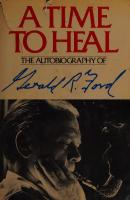A Time to Heal: The Autobiography of Gerald R. Ford 0060112972, 9780060112974
Autobiography of a former President of the United States, detailing both his personal life and career.
189 8 20MB
English Pages 454 [488] Year 1979
Recommend Papers

- Author / Uploaded
- Gerald R. Ford
File loading please wait...
Citation preview
$12.95
ATIME 10 HFAL Gerald R. Ford A Time to Heal is at once the autobiogra
phy of a political career and the human story of a dedicated but unassuming man propelled by history into taking on the immense burdens of the Presi dency. This is a refreshingly unpreten tious yet vivid book. Jerry Ford simply tells it as it was: the journey from mod est Mid wes tern beginnings to the White House-the tough choices, the personal sacrifices, the joys of success, the mistakes, the rousing partisan bat tles, the moments of terror during at tempted assassinations, the times of fear when his beloved wife faced can cer. No less revealing is Ford's account of his controversial decision to pardon Richard Nixon. And we witness every step of the bizarre behind-the-scenes negotiations between Washington and San Clemente-between a new and a fallen President. These pages also offer us an intimate portrait of Gerald Ford's early years: the crushing experience at age sixteen when his natural father-a man Ford had never known-pays a surprise vis it; the hard times the family had to face; the fierce competition and exultation of the football field. There is also his strug gle to be accepted by the Yale Law School, his love af fair with a Cos(continued on back flap)
0679
ATIME TOHfAL
THE AUTOBIOGRAPHY OF
HARPER & ROW, PUBLISHERS AND
THE READER'S DIGEST ASSOCIATION, INC.
Portions of this work originally appeared in Time Magazine and The Reader's Digest.
Copyright © 1979 by Gerald R. Ford. All rights reserved. Printed in the United States of America. No part of this book may be used or reproduced in any manner whatso ever without written permission except in the case of brief quo tations embodied in critical articles and reviews. For information address Harper & Row, Publishers, Inc., 10 East 53rd Street, New York, N.Y. 10022. Published simultaneously in Canada by Fitzhenry & Whiteside Limited, Toronto. A TIME TO HEAL.
FIRST EDITION
Designed by Gloria Adelson
Library of Congress Cataloging in Publication Data Ford, Gerald R. 1913A time to heal. Includes index. 1. Ford, Gerald R., 191!3- 2. Presidents United States-Biography. I. Title. E866.F67 Hl79 973.925'092'4[B] 78-20162 ISBN 0-06-011297-2 79 80 81 82 83 10 9 8 7 6 5 4 3 2 1
to Betty
Contents
1 2 3 4 5 6 7 8
ix Acknowledgments Uncertain Days 1 Boyhood�and Beyond 42 124 Brief Honeymoon Problems Multiply 209 275 · On the Move Challenge from the Right
333
Neek and Neek 408 Moving On 437 443 Index
Photographs follow pages 150 and 246
ACKNOWLEDGMENTS
Reviewing my life and long political career for this book proved to be an enormous undertaking, and one that was often emotionally moving. Only with the help of many people has it been possible to bring back fully and ac curately years of memories. Above all, A Time to Heal would never have come to fruition had it not been for the assistance of Trevor Armbrister, a distinguished journalist and probing reporter. Trevor interviewed me for hundreds of hours, then assisted me in the as sembling and writing of these recollections. Throughout our labors, he dem onstrated a remarkable ability to corral a massive amount of material and to help me convey my innermost feelings and beliefs. Trevor's writing skills and fierce devotion to excellence have made my association with him one of the highlights of my days since leaving the White House. A Time to Heal has been as much a part of his life as it is a portrayal of mine. And for that I am deeply indebted to him. My gratitude also extends to many others. For ideas and guidance: Jack Marsh, Brent Scowcroft, Dean Burch, Robert Barrett, David Kennerly, Paul O'Neill and James Humes. For research and checking: Ann Dear Gavell, John Vardeman, Betty Williamson, Sandra Eisert and archivists of the Ger ald R. Ford Presidential Library. For endless hours of typing transcripts and drafts: Gloria Hill, Linda Hill, Lillian Simasko, Pat Merchant, Pat Lawson, Mary Christie, Jill Burckmyer. For enthusiasm and encouragement: all my staff, past and present, my family and numerous friends-some of whom I write about, some of whom I do not. Finally, for their help and counsel, Harper & Row Publisher Erwin Glikes, Reader's Digest Editor-in-Chief Edward Thompson, Digest Wash ington Editor William Schulz, and the editor of this book, Digest Managing Editor Kenneth Gilmore, who guided all of us with good judgment and skill every step of the way.
"To everything there is a season and a time to every purpose un der the heaven. A time to be born and a time to die; a time to plant and a time to pluck up that which is planted. A time to kill and a time to heal; a time to break down and a time to build up. A time to weep and a time to laugh; a time to mourn and a time to dance." Ecclesiastes 3: 1-4
I
Uncertain Days "I know there is a God. I see the storm coming, and I know His hand is in it. If He has a place for me, and I think He has, I believe I am ready; with God's help I shall not fail." - Abraham Lincoln to his friend Newton Bateman before the Presidential election of 1860
S
hortly before nine o'clock on the warm, cloudy morning of Au gust 1, 1974, I received a telephone call from General Alexander M. Haig, Jr. For the past fifteen months-ever since the resignations of H. R. Haldeman and John Ehrlichman-Haig had been serving as White House chief of staff, and he had done a magnificent job in an almost impossible situation. "Mr. Vice President," he said, "it's urgent that I see you as soon as possible." From the tone of his voice I could tell that something very impor tant was happening and that he didn't want to discuss it on the tele phone. "Well, sure," I replied. "Come on over now. We have some meetings on the schedule, but we can push them back." Fifteen minutes later, Haig arrived at my office on the second floor of the Executive Office Building. Robert Hartmann, the brusque former newspaperman who was serving as my chief of staff, had been talking with me about routine business, and I'd asked him � l
2
A TIME TO HEAL
to stay for the session with Haig. This, too, was routine. Whenever I had a meeting on a matter (!f some importance, the staff always made sure that a witness was there. But Haig did not know Hart mann well. He seemed surprised by his presence, and I had the im pression that he didn't feel he could be as forthright as he might nor mally have been. Still, what be did say was worrisome enough. Eight days earlier, on July 24, the Supreme Court had ruled that President Richard M. Nixon had to turn over to U.S. District Court Judge John J. Sirica the recordings of sixty-four conversations that had been taped in the President's offices. The Court felt that they might contain evidence for the pending cover-up trial of six of Nix on's former aides. The President had already turned over transcripts of twenty of those tapes; others were scheduled to be delivered to Sir ica on Monday, August 5. And those others were the ones that both ered Haig. "I want to alert you that things are deteriorating," he said. "The whole ball game may be over. You'd better start thinking about a change in your life. I can't tell you what's going to happen, but I have to tell you what I know." The new tapes, he said, contained evidence that would contradict Nixon's version of events in the Watergate scandal. The evidence would prove that Nixon knew about the cover-up six days after the break-in at Democratic National Committee headquarters and that he'd been deceiving the American people ever since. He hadn't seen the evidence himself, Haig said, but he'd been told about it by people who had. They had explained that it contained the so-called smoking gun, and he felt sure that they were telling the truth. I asked for more details. He said that at the moment he couldn't tell me anything more. The tapes were being transcribed. Eventually he'd have copies, but he didn't have them yet. And if those tran scripts contained the evidence that he'd been told they would, then the President's chances of escaping impeachment in the House of Representatives-and conviction in the Senate-would disappear. He hadn't even suspected the existence of this new evidence. Neither, he added, had the President's attorney, James St. Clair. Like so many other Americans, they had believed Nixon's repeated assertions of in nocence. Unknowingly, St. Clair had misrepresented the President's
UNCERTAIN DAYS
3
case before the House Judiciary Committee. St. Clair, Haig said, was angry about that now. I understood that. I was angry too. There was n'othing more to be said. After forty-five minutes, Haig returned to the White House. I swore Hartmann to secrecy, then con centrated on catching up with my schedule. My heart wasn't in it. For the past eight months, ever since I had become Vice President, I had been hoping against hope that Watergate would go away, that Nixon would prove his innocence of involvement in the affair, that the basic civility of our political process would return. Now those hopes were evaporating fast. Shortly after noon that day, I drove to Capitol Hill. No sooner had I entered my office off the Senate floor than Haig telephoned again. He wanted another meeting as soon as possible, and this time he didn't want Hartmann there. When Haig appeared at three-thirty that afternoon, he looked even more beaten and harassed than he had earlier. Since our morn ing meeting, he had either read the transcripts or heard them dis cussed in great detail. The tapes made clear that Nixon knew the whole story on June 23, 1972. And when that evidence became pub lic, Nixon's case would disintegrate. In moments of stress, Haig pro ceeds very deliberately, choosing his words with great care. Now he came to the point: "Are you ready, Mr. Vice President, to assume the Presidency in a short period of time?" "If it happens, Al, I am prepared," I said. Our conversation that day had an unusual formality, both of us aware that we were speak ing not only as friends but also for the record book. "I can't tell you what's going to happen in the next forty-eight hours," he went on. "I just don't know what the President is going to do." Haig said he had discussed the new evidence with Nixon the afternoon before, and Nixon had brushed it off by saying that it was "manageable." Everyone else who knew about it disagreed. Careful ly, Haig laid out the options that the "knowledgeable people" on the White House staff had agreed were still available to the President. The first was that he could try to "ride it out" by letting impeach ment take its natural c






![The President: A Minute-by-minute Account of a Week in the Life of Gerald Ford [1 ed.]
0394459865, 9780394459868](https://ebin.pub/img/200x200/the-president-a-minute-by-minute-account-of-a-week-in-the-life-of-gerald-ford-1nbsped-0394459865-9780394459868.jpg)


